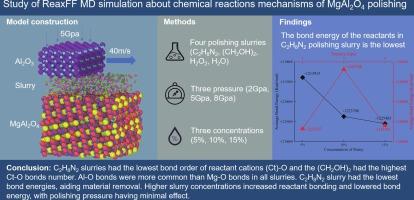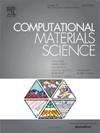Study of ReaxFF molecular dynamics simulation about chemical reactions mechanisms of magnesium-aluminium spinel polishing
IF 3.1
3区 材料科学
Q2 MATERIALS SCIENCE, MULTIDISCIPLINARY
引用次数: 0
Abstract
Chemical mechanical polishing (CMP) is the predominant method for finishing hard and brittle materials that are challenging to machine. We proposed replacing the soft polishing pads used in traditional CMP with hard ceramic plate to offer rigid support for polishing magnesia-alumina spinel (MgAl2O4) and to achieve better flatness. However, the chemical reaction mechanisms occurring during the process remain unclear. In this study, we employed ReaxFF molecular dynamics (MD) simulations to investigate the chemical reaction mechanisms between MgAl2O4 and the polishing slurries (ethylene glycol, ethylenediamine, hydrogen peroxide, water) during the polishing process. We found that reactions mostly involved –OH chemisorption. Ethylenediamine (C2H8N2) slurries had the lowest bond order of reactant cations (Ct) with −O and the highest ethylene glycol ((CH2OH)2) Ct-O bonds. Al-O bonds were more common than Mg-O bonds in all slurries. C2H8N2 slurry had the lowest bond energies, aiding material removal. Higher slurry concentrations increased reactant bonding and lowered bond energy, with polishing pressure having minimal effect. Our results clarify the atomic-level chemical mechanisms of MgAl2O4 polishing. This provides a valuable approach for designing chemically reactive polishing slurries and offers theoretical support for the efficient removal of MgAl2O4 materials.

ReaxFF分子动力学模拟镁铝尖晶石抛光化学反应机理的研究
化学机械抛光(CMP)是加工硬脆材料的主要方法。我们提出用硬陶瓷板代替传统CMP中使用的软抛光垫,为抛光镁铝尖晶石(MgAl2O4)提供刚性支撑,并获得更好的平整度。然而,在此过程中发生的化学反应机制尚不清楚。在本研究中,我们采用ReaxFF分子动力学(MD)模拟研究了MgAl2O4与抛光液(乙二醇、乙二胺、过氧化氢、水)在抛光过程中的化学反应机理。我们发现反应主要涉及-OH化学吸附。乙二胺(C2H8N2)浆料与−O的反应阳离子(Ct)键序最低,乙二醇((CH2OH)2) Ct-O键序最高。在所有浆料中,Al-O键比Mg-O键更常见。C2H8N2浆料的键能最低,有利于材料的去除。较高的浆液浓度增加了反应物的结合,降低了键能,抛光压力的影响最小。我们的研究结果阐明了MgAl2O4抛光的原子级化学机制。这为设计化学反应性抛光浆料提供了有价值的方法,并为MgAl2O4材料的高效去除提供了理论支持。
本文章由计算机程序翻译,如有差异,请以英文原文为准。
求助全文
约1分钟内获得全文
求助全文
来源期刊

Computational Materials Science
工程技术-材料科学:综合
CiteScore
6.50
自引率
6.10%
发文量
665
审稿时长
26 days
期刊介绍:
The goal of Computational Materials Science is to report on results that provide new or unique insights into, or significantly expand our understanding of, the properties of materials or phenomena associated with their design, synthesis, processing, characterization, and utilization. To be relevant to the journal, the results should be applied or applicable to specific material systems that are discussed within the submission.
 求助内容:
求助内容: 应助结果提醒方式:
应助结果提醒方式:


